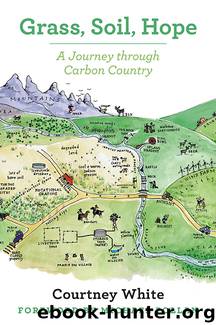Grass, Soil, Hope: A Journey through Carbon Country by Michael Pollan

Author:Michael Pollan
Language: eng
Format: epub
Published: 2014-05-02T04:00:00+00:00
* * *
Leave It to Beavers
SHERRI TIPPIE, CREEKS ALL OVER COLORADO
Sometimes it takes a hairdresser to explain things.
In 2003, I invited Sherri Tippie, a self-described hairdresser from Aurora, Colorado, a suburb of Denver, to speak at a Quivira Coalition conference, where she urged the many ranchers in the audience to give beavers a chance. She knew the odds. For decades, the typical response of landowners to the presence of a beaver pond and gnawed trees on their property involved a gun, a trap, or a stick of dynamite. Beavers were considered “varmints” by many rural residents, who accused them of drowning productive fields, drying up irrigation ditches, plugging road culverts, and ruining valuable timber. And what do you do with varmints? You get rid of them.
“Don’t,” Tippie cheerfully told the crowd. “Beavers are your friends.”
In a twenty-five year-career of rescuing and relocating the critters, Tippie has campaigned relentlessly to explain the positive things that beavers can do for landowners, which include reducing the risk of flooding, raising water tables, creating wetlands, and improving water quality and quantity—all good stuff in dry country like much of the American West. It’s especially good if the country is suffering from a drought, as it is these days. Leaky beaver dams store water that would otherwise be lost—a message that ranchers and others are beginning to hear loud and clear as the West braces for a hotter and drier future.
Of all the good things beavers do, however, the least appreciated may be their role as carbon engineers. By one estimate, as much as 1 meter of sediment per year is caught behind beaver dams, and some sites can be occupied for as long as fifty years. Many dams are large as well, often stretching 1,500 feet. In 2010, researchers in northern Alberta, Canada, discovered the world’s biggest beaver dam, which at nearly 2,800 feet is twice the length of Hoover Dam! Beaver dams also create wetlands around their edges, which are well known for their carbon-storing capacity. For example, in the Upper Mississippi– Missouri River basin, researchers say, there were once over 50 million acres of beaver ponds. Although the total today is down to roughly 500,000 acres, that’s still a lot of carbon sequestration going on—with the potential for much more.
Carbon sequestration wasn’t something Tippie covered back in 2003, but it might very well be part of her pitch today. Growing up on the Front Range, she developed a love for wildlife at a young age. In 1981, in the midst of her salon career, she decided to act on her feelings by getting involved in efforts to stop state and federal agencies from poisoning coyotes near where she lived. Then one afternoon in 1985, “while scrubbing the floor with the TV on,” as she described it, she heard a story about how Aurora had hired a trapper to kill beavers who were taking down trees on a city golf course. The newscaster said killing was necessary because there was no place to put them.
Download
This site does not store any files on its server. We only index and link to content provided by other sites. Please contact the content providers to delete copyright contents if any and email us, we'll remove relevant links or contents immediately.
The Lonely City by Olivia Laing(4567)
Animal Frequency by Melissa Alvarez(4148)
All Creatures Great and Small by James Herriot(3983)
Walking by Henry David Thoreau(3681)
Exit West by Mohsin Hamid(3634)
Origin Story: A Big History of Everything by David Christian(3471)
COSMOS by Carl Sagan(3346)
How to Read Water: Clues and Patterns from Puddles to the Sea (Natural Navigation) by Tristan Gooley(3239)
How to Do Nothing by Jenny Odell(3101)
The Inner Life of Animals by Peter Wohlleben(3099)
Hedgerow by John Wright(3096)
How to Read Nature by Tristan Gooley(3077)
Project Animal Farm: An Accidental Journey into the Secret World of Farming and the Truth About Our Food by Sonia Faruqi(3016)
Origin Story by David Christian(2991)
Water by Ian Miller(2950)
A Forest Journey by John Perlin(2914)
The Plant Messiah by Carlos Magdalena(2745)
A Wilder Time by William E. Glassley(2687)
Forests: A Very Short Introduction by Jaboury Ghazoul(2671)
